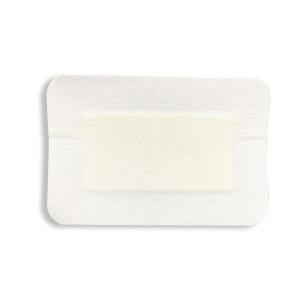
Add to Cart
OEM Waterproof Non Woven Fabrics Calcium Alginate Wound Dressing With 6*10cm
Overview:
Alginate wound dressing is a functional wound dressing with high hygroscopicity composed of stearate, the medical wound dressing can form a soft and transparent gel when contacted with wound exudate, which provides an ideal moist environment for wound closure and promotes wound healing. relieve wound pain
Spicification:
| Item | value |
| product name | silver alginate wound dressing |
| Place of Origin | China |
| Brand Name | OEM |
| Disinfecting Type | NOT STERILE |
| Size | Customization |
| Stock | NO |
| Shelf Life | 2 years |
| Instrument classification | Class l |
| Type | Blologically Active Dressing in sheet |
| Color | White |
| sterile | EO |
| specification | sheet or roll |
| structure | The non-adhesive type of chitosan dressing consists of a chitosan dressing cushion. Adhesive type of chitosan dressing consists of chitosan Chitosan dressing cushion, medical absorbent cushion, medical tape layer and anti-adhesive paper. |
| function | When the medical film comes into contact with wound exudate, it forms a soft gel that provides an ideal moist environment for wound healing, promotes wound healing and relieves wound pain. |
Feature:
1. Gelation: Absorb wound exudate and exchange Na+/Ca2+ ion with the exudate, forming a layer of stable net-like gel on the wound surface. Create a micro-environment conducive to tissue growth for the wound (slightly acid, anaerobic or hypoxic, moderately moist).
2. Promote wound healing: A slightly acidic, anaerobic or hypoxic, moderately moist wound environment promotes the release of growth factors, stimulates cell proliferation, improves the regenerative capacity of epidermal cells and cell movement, and promotes wound healing.
Function:
1. Obstetrics, incision healing and incision fat liquefaction treatment after caesarean section;
2. Ottofish throat, with dry cavity wound packing;
3. Urology, minimally invasive cavity wound packing;
4. Plastic surgery department;
5. Treatment of exudate and local stop, high exudation wound;
6. Wounds with moderate to severe exudates and cavities, such as pressure ulcers, bedsore wounds
7. Diabetic foot ulcer wounds, lower extremity venous/arterial ulcer wounds, granulation tissue and slough covered wounds:
Usage:
1. Wash the wound with saline or sterile water, and gently dry the skin around the wound.
2. After debridement and disinfection, according to the size of the wound, use sterile scissors to cut the alginate wound dressing into a size suitable for the wound.
3. Select the outer covering film (PU film is recommended) and cut it accordingly, so that the alginate wound dressing can be well fixed and covered on the wound.
4, The time for each piece of sea temperature salt wound to cover the wound with a thin layer is generally 2-7 days. The frequency of new dressing changes should be judged according to the amount of wound exudate and the degree of wound closure. When the pick-up is being delivered
When the liquid is saturated, it needs to be replaced in time; when the granulation tissue begins to form, the exudate is reduced, and the number of replacements is correspondingly reduced.
5. After mixing with normal saline, the dressing can be easily removed with medical tweezers.

Precautions:
1.If the wound is mainly caused by insufficient arterial blood supply or diabetic foot ulcer, the conditions for using this medical film are: use under the guidance of medical staff, and medical staff should always evaluate the patient's clinical indications and check the wound condition.
2. The alginate medical film is not suitable for large and continuous bleeding situations that cannot be controlled by the body's physiological mechanism and must be stopped by surgical means.
3. For dry wounds, this medical film is not recommended.
Product pictures:
